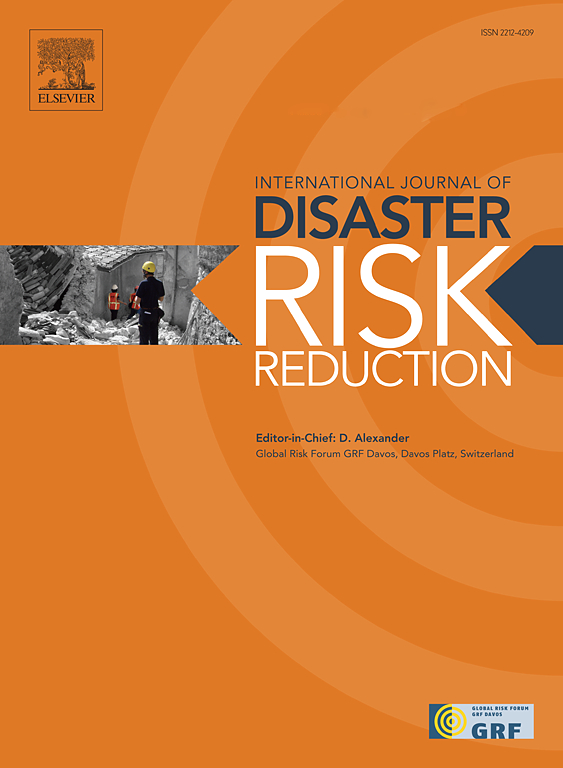Developing a multi-level european-wide composite indicator to assess vulnerability dynamics across time and space
IF 4.2
1区 地球科学
Q1 GEOSCIENCES, MULTIDISCIPLINARY
International journal of disaster risk reduction
Pub Date : 2024-10-05
DOI:10.1016/j.ijdrr.2024.104885
引用次数: 0
Abstract
The escalating frequency of extreme climatic events and ongoing urbanisation expose European communities to increasing disaster risks, which are determined not only by the hazardous events themselves, but also by the exposure and vulnerability to these hazards. Consequently, effective risk management strategies cannot overlook a comprehensive understanding of the factors influencing vulnerability of the communities. This paper addresses this need by presenting a European-wide framework for the development of a Vulnerability Index (VI) that evaluates vulnerability at both national and subnational scales. Adopting a multi-dimensional and multi-level approach, the VI captures socio-economic, political, environmental, and physical factors contributing to community resilience. A standardised, supranational methodology is employed, providing harmonised cross-country information and time series data for vulnerability and its underlying indicators. This comprehensive assessment facilitates the understanding of socio-economic dynamics, enabling the formulation of targeted policy actions at both country and subnational levels. By offering insights into current vulnerability trends, the VI underlines the importance of governance, economic factors, and disaster preparedness in reducing vulnerability at different administrative levels, while highlighting the role of social factors, such as poverty and social exclusion, in community vulnerability at sub-regional levels.
制定全欧洲多层次综合指标,评估跨时空的脆弱性动态
极端气候事件的频发和持续的城市化使欧洲社区面临越来越大的灾害风险,而这些风险不仅取决于危险事件本身,还取决于暴露于这些灾害的程度和易受影响的程度。因此,有效的风险管理战略不能忽视对影响社区脆弱性的因素的全面了解。本文针对这一需求,提出了一个全欧洲范围的脆弱性指数(VI)开发框架,以评估国家和国家以下范围的脆弱性。脆弱性指数采用了多维度和多层次的方法,捕捉了导致社区复原力的社会经济、政治、环境和物理因素。采用标准化的超国家方法,为脆弱性及其基础指标提供统一的跨国信息和时间序列数据。这种综合评估有助于了解社会经济动态,从而在国家和国家以下层面制定有针对性的政策行动。通过深入了解当前的脆弱性趋势,《脆弱性六》强调了治理、经济因素和备灾在降低不同行政级别脆弱性方面的重要性,同时突出了贫困和社会排斥等社会因素在次区域一级社区脆弱性中的作用。
本文章由计算机程序翻译,如有差异,请以英文原文为准。
求助全文
约1分钟内获得全文
求助全文
来源期刊

International journal of disaster risk reduction
GEOSCIENCES, MULTIDISCIPLINARYMETEOROLOGY-METEOROLOGY & ATMOSPHERIC SCIENCES
CiteScore
8.70
自引率
18.00%
发文量
688
审稿时长
79 days
期刊介绍:
The International Journal of Disaster Risk Reduction (IJDRR) is the journal for researchers, policymakers and practitioners across diverse disciplines: earth sciences and their implications; environmental sciences; engineering; urban studies; geography; and the social sciences. IJDRR publishes fundamental and applied research, critical reviews, policy papers and case studies with a particular focus on multi-disciplinary research that aims to reduce the impact of natural, technological, social and intentional disasters. IJDRR stimulates exchange of ideas and knowledge transfer on disaster research, mitigation, adaptation, prevention and risk reduction at all geographical scales: local, national and international.
Key topics:-
-multifaceted disaster and cascading disasters
-the development of disaster risk reduction strategies and techniques
-discussion and development of effective warning and educational systems for risk management at all levels
-disasters associated with climate change
-vulnerability analysis and vulnerability trends
-emerging risks
-resilience against disasters.
The journal particularly encourages papers that approach risk from a multi-disciplinary perspective.
 求助内容:
求助内容: 应助结果提醒方式:
应助结果提醒方式:


